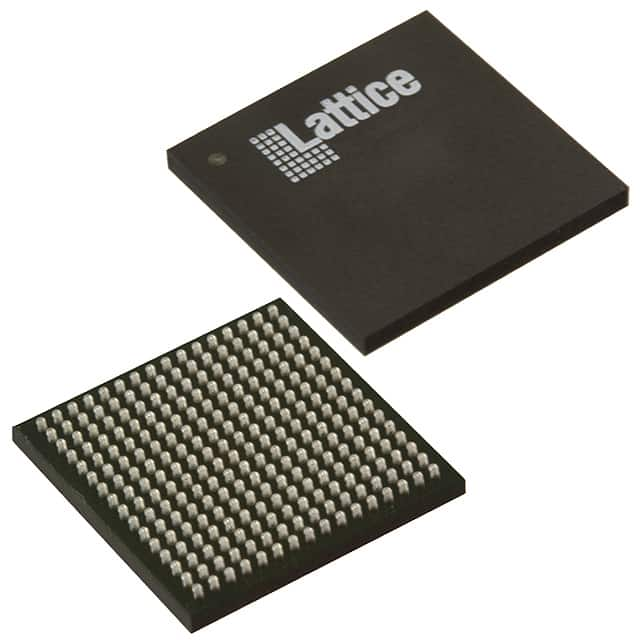LCMXO1200C-3B256I
Product Overview
Category
The LCMXO1200C-3B256I belongs to the category of Field Programmable Gate Arrays (FPGAs).
Use
FPGAs are integrated circuits that can be programmed and reprogrammed to perform various digital functions. The LCMXO1200C-3B256I is specifically designed for applications requiring high-performance and low-power consumption.
Characteristics
- High-performance FPGA with low power consumption
- Compact size and lightweight design
- Flexible and reprogrammable functionality
- Suitable for a wide range of applications
Package
The LCMXO1200C-3B256I comes in a compact package, ensuring easy integration into electronic systems. It is available in a surface-mount form factor.
Essence
The essence of the LCMXO1200C-3B256I lies in its ability to provide customizable digital logic functions, enabling designers to implement complex algorithms and systems on a single chip.
Packaging/Quantity
The LCMXO1200C-3B256I is typically packaged in reels or trays, depending on the manufacturer's specifications. The quantity per package may vary, but it is commonly available in quantities suitable for both prototyping and production purposes.
Specifications
- FPGA Family: Lattice XO2
- Logic Cells: 1200
- Speed Grade: -3
- I/O Pins: 256
- Operating Voltage: 1.2V
- Package Type: BGA
- Package Pins: 256
- Temperature Range: -40°C to +85°C
Detailed Pin Configuration
The LCMXO1200C-3B256I has a total of 256 I/O pins, which are configurable based on the specific application requirements. The pin configuration can be found in the product datasheet provided by the manufacturer.
Functional Features
- High-speed performance: The LCMXO1200C-3B256I offers fast processing capabilities, making it suitable for applications that require real-time data processing.
- Low power consumption: This FPGA is designed to minimize power consumption, making it ideal for battery-powered devices or energy-efficient systems.
- Reconfigurability: The LCMXO1200C-3B256I allows users to modify and reprogram the logic functions, enabling flexibility and adaptability in various applications.
- Integrated peripherals: It includes built-in features such as memory blocks, digital signal processing (DSP) slices, and clock management resources, enhancing its functionality.
Advantages and Disadvantages
Advantages
- Versatility: The LCMXO1200C-3B256I can be used in a wide range of applications due to its customizable nature.
- Cost-effective: FPGAs eliminate the need for custom ASIC development, reducing overall costs for certain projects.
- Rapid prototyping: The reprogrammable nature of FPGAs allows for quick iterations during the development phase.
Disadvantages
- Complexity: Designing and programming FPGAs requires specialized knowledge and expertise.
- Limited performance compared to dedicated hardware: While FPGAs offer high-performance capabilities, they may not match the performance of dedicated application-specific integrated circuits (ASICs) in certain scenarios.
Working Principles
The LCMXO1200C-3B256I operates based on the principles of configurable logic. It consists of an array of programmable logic cells interconnected through configurable routing resources. These logic cells can be programmed to implement various digital functions, such as arithmetic operations, data storage, and control logic. The configuration of the FPGA is stored in non-volatile memory and can be modified as needed.
Detailed Application Field Plans
The LCMXO1200C-3B256I finds applications in various fields, including but not limited to: - Communications: It can be used for protocol conversion, signal processing, and data encryption. - Industrial automation: The FPGA's reprogrammability allows for flexible control systems and real-time monitoring. - Automotive electronics: It can be utilized for advanced driver assistance systems (ADAS), engine control units (ECUs), and infotainment systems. - Medical devices: FPGAs enable the implementation of complex algorithms in medical imaging, patient monitoring, and diagnostic equipment.
Detailed and Complete Alternative Models
- LCMXO640C-3BN256I
- LCMXO2280C-3FTN256C
- LCMXO2-7000HE-5TG144C
These alternative models offer similar functionality and performance characteristics to the LCMXO1200C-3B256I. However, it is recommended to consult the respective datasheets for detailed specifications and pin configurations.
*Note: The content provided above is a sample structure for an encyclopedia entry and may
技術ソリューションにおける LCMXO1200C-3B256I の適用に関連する 10 件の一般的な質問と回答をリストします。
Sure! Here are 10 common questions and answers related to the application of LCMXO1200C-3B256I in technical solutions:
Q: What is the LCMXO1200C-3B256I? A: The LCMXO1200C-3B256I is a low-cost, low-power FPGA (Field-Programmable Gate Array) device manufactured by Lattice Semiconductor.
Q: What are the key features of the LCMXO1200C-3B256I? A: Some key features include 1200 Look-Up Tables (LUTs), 64 I/O pins, 256 kilobits of embedded block RAM, and support for various I/O standards.
Q: What are some typical applications of the LCMXO1200C-3B256I? A: The LCMXO1200C-3B256I is commonly used in applications such as industrial control systems, consumer electronics, communication devices, and automotive systems.
Q: How can I program the LCMXO1200C-3B256I? A: The LCMXO1200C-3B256I can be programmed using Lattice Diamond or Lattice Radiant software tools, which provide a graphical interface for designing and programming the FPGA.
Q: What voltage levels does the LCMXO1200C-3B256I support? A: The LCMXO1200C-3B256I supports both 3.3V and 1.2V voltage levels, making it compatible with a wide range of digital logic systems.
Q: Can I use the LCMXO1200C-3B256I in battery-powered applications? A: Yes, the LCMXO1200C-3B256I is designed to be low-power and can be used in battery-powered applications where power consumption is a concern.
Q: Does the LCMXO1200C-3B256I support external memory interfaces? A: Yes, the LCMXO1200C-3B256I has embedded block RAM that can be used for storing data, but it also supports external memory interfaces such as SPI or I2C.
Q: Can I use the LCMXO1200C-3B256I for real-time signal processing? A: Yes, the LCMXO1200C-3B256I's high-speed I/O pins and programmable logic make it suitable for real-time signal processing applications.
Q: Are there any development boards available for the LCMXO1200C-3B256I? A: Yes, Lattice Semiconductor offers development boards like the iCE40 UltraPlus Breakout Board, which can be used with the LCMXO1200C-3B256I.
Q: Where can I find more information about the LCMXO1200C-3B256I? A: You can find more detailed information about the LCMXO1200C-3B256I, including datasheets, application notes, and reference designs on the Lattice Semiconductor website.


